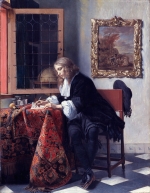The Royal Society published Michael Butterfield's letter about melting glass to make spherical lenses
Michael Butterfield (1634-1724) was an English engineer and mathematician who lived most of his life in France. His lifetime was almost the same as Leeuwenhoek’s.
He made instruments such as sundials and graphometers for King Louis XIV.
In 1677, Butterfield wrote a letter to the Royal Society describing how to make a lens by melting a bit of glass and mounting it between two brass plates.
This method was described by Hooke in Mircographia in 1665 and it was similar to the method Leeuwenhoek used for some of his lenses.
Philosophical Transactions vol. 12 no. 141 p. 1026
Extract of a Letter from Mr. Butterfield Mathematique Instrument-maker to the French King, about the making of Microscopes with very small and single glasses: and of some other instruments.
I Doubt not but you may be as busie at London as we are here in making of Microscopes of the manner lately brought out of Holland by Mr. Huigens, whereof I have several fashions ready made. I have tried several ways for the making of Glasses of the bigness of a great Pins head and lefs; as in the flame of a Tallow candle, and of one of Wax.
But the best way of all I have yet found, to make them clear and without specks, is with the flame of Spirit of Wine well rectified and burned in a Lamp. Instead of Cotton I make use of very small silver wire doubled up and down like a skein of thred; which being wet with the Spirit of Wine, and made to burn in the Lamp, giveth through the veril of the Lamp a very ardent flame.
Then take your beaten Glass, being first washed very clean, upon the point of a Silver needle filed very small and wet with spittle. Hold it thus in the flame till it be quite round, and no longer for fear of burning it, and if the side of the Glass next the needle be not melted, you may put it off and take it up with the needle on the round side, presenting the rough side to the flame till it be every where very round and smooth, then wipe and rub one or several of them together with soft leather, which makes them much the better. Then put them between two pieces of thin brass, the Apertures very round and without bur, and that towards the eye so big almost as the diameter of the Glass: and so placed in a Frame with the object conveniently for observation.
I published laft year in the Journal de Scavans a trial of mine Invention with a Tube with Glasses and a Thred hanging between four points, with a Weight in a Box so contrived, that as soon as the Instrument is set down, you have your point of Horzon with a great deal of exactness. It hath been so well approved of, that the River which the King maketh to come twenty Leagues off to Paris, is conduced by it,
At present I am finishing another. Instead of four points it playeth on one Steel point, standing on a Diamond: the making of which I do intend to publish. I hope it will be of great use for its exactness and speediness of working.
I am at present making a silver Planisphere of two foot diameter for the King; the Invention of that famous Astronomer, and my very good friend, Mr. Cassini. It sheweth a very easie way to know and find out most of the fixed Star and the hour of the night very speedily.















